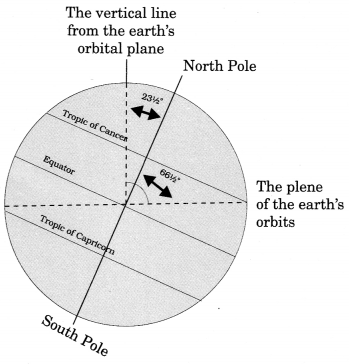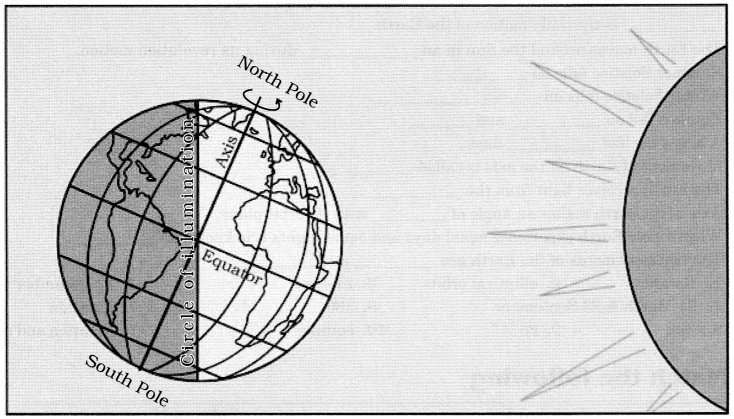Motions of the Earth Class 6 Geography Chapter 3 Extra Questions and Answers Social Science CBSE Pdf free download are part of Extra Questions for Class 6 Social Science. Here we have given NCERT Extra Questions for Class 6 Social Science SST Geography Chapter 3 Motions of the Earth.
You can also practice NCERT Solutions for Class 6 Geography Chapter 3 Questions and Answers on LearnInsta.com.
Class 6 Geography Chapter 3 Extra Questions and Answers Motions of the Earth
Motions of the Earth Class 6 Extra Questions and Answer Geography Chapter 3 Very Short Answers Type
Question 1.
State the number of motions of the Earth.
Answer:
The Earth has two types of motions.
Question 2.
Name of motions of the Earth.
Answer:
These are rotation and revolution.
Question 3.
What do you mean by rotation of the Earth?
Answer:
Rotation is the movement of the Earth on its axis.
Question 4.
How many hours are taken by Earth to complete one rotation?
Answer:
It takes about 24 hours to complete one rotation.
Question 5.
On which imaginary point does the Earth rotate?
Answer:
On its axis.
Question 6.
What is resulted by the rotation on axis by the Earth?
Answer:
Due to the rotation of axis, day and night are formed.
Question 7.
What angle does axis of the Earth make with its orbital plane?
Answer:
The axis of the Earth makes an angle of 66 1/2° with its orbit plane.
Question 8.
What do you mean by revolution of the Earth?
Answer:
Revolution is movement of the Earth around the Sim in a fixed path or orbit.
Question 9.
How much time is taken to complete the cycle in revolution?
Answer:
It takes 365 1/4 days (one year) to complete it.
Question 10.
What results occur due to the revolution movement?
Answer:
Due to the revolution movement, seasons are changed.
Question 11.
Who gives the light to the Earth?
Answer:
The Sun gives light to the Earth.
Question 12.
Why does only half portion of the Earth get light in a time?
Answer:
Due to the spherical shape of the Earth, it receives only half portion at a time.
Question 13.
What is circle of illumination?
Answer:
The circle that divides the day from night on the globe is called the ‘circle of illumination’.
Question 14.
What do you understand about the ‘Earth day’?
Answer:
The period of rotation is known as the ‘Earth day’
Question 15.
Give the names of seasons in a year.
Answer:
There are 4 seasons in a year – summer, winter, spring and autumn.
Question 16.
What do you understand about ‘equinox’?
Answer:
When the whole earth experiences equal day and night, the position is called ‘equinox’.
Question 17.
When does equinox fall?
Answer:
On 21 March and 23 September.
Question 18.
What do you mean about Summer Solstice?
Answer:
When the northern Hemisphere has the longest day and the shortest night it is called Summer Solstice. It occurs on 21 June.
Question 19.
What do you mean by Winter Solstice?
Answer:
When the southern Hemisphere has the longest day and the shortest night it is called Winter Solstice. It occurs on 22 December.
Motions of the Earth Class 6 Extra Questions and Answer Geography Chapter 3 Long Answers Type
Question 1.
How is a leap year formed?
Answer:
Actually, the Earth takes 365 Vi days to revolve around the Sun. It means 6 hours excess in every year and these 6 hours makes 1 day in 4 years. After every 4 years, 1 day is added in the month of February. Thus, every fourth year, February is of 29 days instead of 28 days. Such a year with 366 days is called a leap year.
Question 2.
What would happen if the Earth did not rotate?
Answer:
If the Earth stops to rotate, the portion of the Earth which is facing the Sun would always experience day and would be hot, while the other half would remain in darkness and be freezing cold all the time. Life would not have been possible in such extreme conditions of hot and cold.
Question 3.
Christmas in Australia is celebrated in the summer season. Explain.
Answer:
In all over the world, Christmas days is celebrated on 25 December in each year. Australia falls under southern hemisphere. In the month of December, the Tropic of Capricorn receives the direct rays of the Sun and the South Pole tilts towards it. Thus, it is summer in the Southern Hemisphere at this time and hence Australia celebrates Christmas in summer season.
Question 4.
How does leap year occur? Calculate.
Answer:
The year in which 1 day exceeds to the normal year’s 365 days. Thus, the year which has 366 days is called a leap year. The revolution movement takes 365 V4 days (one year and 6 hrs) to revolve around the Sun. These 6 hours saved every year and make 1 day in 4 years. This 1 day is added to the month of February. Thus, every fourth year, February is of 29 days instead of 28 days. Such a year with 366 days is called a leap year.
Picture Based Questions Class 6 Geography Chapter 3 Motions of the Earth
Study the picture and answer the question.
Question 1.
Indicate through picture: inclination of the Earth’s axis and the orbital plane
Answer:

Question 2.
Indicate through picture: day and night on the Earth due to rotation.
Answer:
